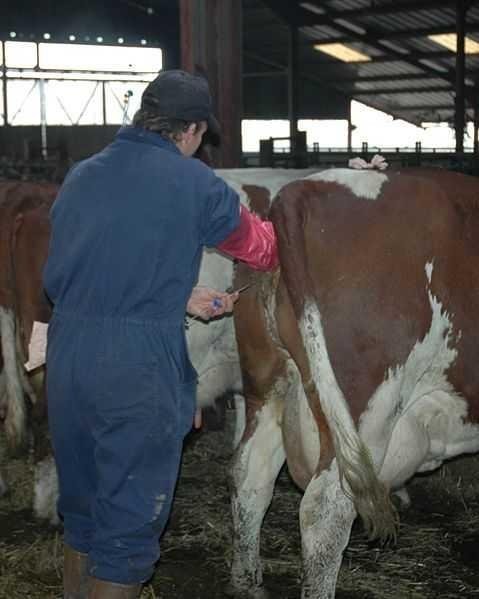Increasing Productivity Through Artificial Insemination
With the rapid increase seen in human population over the years, it is expedient to create channels and systems to feed this ever increasing population.
Efforts have been made in the field of agronomy which has made tremendously impact and still making, but this article isn't about crop but animals since crop and animal products makes up human foodstuff.
What is artificial insemination?

[image credits: Wikipedia Commons]
Artificial insemination is a way of improving the performance of animal when breeding or reproducing. Artificial insemination entails taking semen from male and placing it in the female using artificial insemination gun.
Benefits of artificial insemination
Artificial insemination eradicates the transfer of undesirable genes. It gives the farmers the opportunity to choose the trait which will be seen in the offspring. This method reduces the spread of diseases, both venereal and other communicable diseases.
Cost of taking care of individual mother after giving birth is reduced because they all give birth at the same time or almost the same time.
The male do not have to do much work in chasing the female about and the male is equally freed from overworking itself through copulating with many females in a day.
The semen taken can be used for many females and can be transported to other cities or countries.
Artificial insemination equally eradicates the chances of a female not willing to accept a male.
Ills of artificial insemination
If the semen is not properly stored, the entire effort might be wasted. The process is laborious and requires a lot of expertise and specialized equipments. The selection of animals on heat might be wrongly done because of late detection or wrong predictions. When instruments used are not thoroughly washed or cleaned, this may lead to spread of diseases.
How to carry out artificial insemination
First, the animal to be inseminated must be on heat. There are signs to show that the animal is on heat, which are: Restlessness, frequent urination, nervousness,swelling of vulva, Reduced feed intake, mucus discharge from vulva, mounting other animals.
The animal from whom the semen is to be collected is made to mount a service crate and the artificial vagina is attached to the penis. When the animal ejaculate, the semen is deposited into the vagina attached. This is then detached and stored appropriately.
Afterward, the semen is taken from the storage tank made of plastic and allowed to cool for some minutes before loading it into the artificial insemination gun.
The female to be artificially inseminated must be on heat, this takes place once in 18-24 days and it last for a day.
The animal must be cooled prior to the operation. The inseminator will place his hands into the animal via the rectum, once the cervix is grabbed, the artificial insemination gun is inserted through the vulva into the vagina and the semen is then released and the gun withdrawn from the animal's body.
Reference
https://m.wikihow.com/Artificially-Inseminate-Cows-and-Heifers
http://www-naweb.iaea.org/nafa/aph/resources/technology-ai.html
https://www.agric.wa.gov.au/genetics-selection/artificial-breeding-beef-cattle
https://www.afimilk.com/afiblog/cow-insemination-how-does-it-work
Hi btoye,
Nice topic there. This brought to reminiscence my high school agricultural science.
I've got a little tip for you for your next post.
It is strongly recommended that references should be added to STEM posts. Because this would substantiate your claims and give more credibility to your post.
Thanks and cheers

Thank you so much. I remembered that I haven't done that this morning. Will do that right away.
.
Thanks for stopping by
This post has been voted on by the SteemSTEM curation team and voting trail in collaboration with @curie.
If you appreciate the work we are doing then consider voting both projects for witness by selecting stem.witness and curie!
For additional information please join us on the SteemSTEM discord and to get to know the rest of the community!